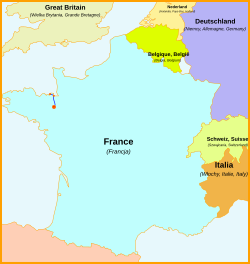Rennes – Saint-Malo railway line
| Rennes – Saint-Malo | |||||||||||||||||||||||||||||||||||||||||||||||||||||||||||||||||||||||||||||||||||||||||||||||||||||||||||||||||||||||||
|---|---|---|---|---|---|---|---|---|---|---|---|---|---|---|---|---|---|---|---|---|---|---|---|---|---|---|---|---|---|---|---|---|---|---|---|---|---|---|---|---|---|---|---|---|---|---|---|---|---|---|---|---|---|---|---|---|---|---|---|---|---|---|---|---|---|---|---|---|---|---|---|---|---|---|---|---|---|---|---|---|---|---|---|---|---|---|---|---|---|---|---|---|---|---|---|---|---|---|---|---|---|---|---|---|---|---|---|---|---|---|---|---|---|---|---|---|---|---|---|---|---|
| Route number (SNCF) : | 441000 | ||||||||||||||||||||||||||||||||||||||||||||||||||||||||||||||||||||||||||||||||||||||||||||||||||||||||||||||||||||||||
| Route length: | 81 km | ||||||||||||||||||||||||||||||||||||||||||||||||||||||||||||||||||||||||||||||||||||||||||||||||||||||||||||||||||||||||
| Gauge : | 1435 mm ( standard gauge ) | ||||||||||||||||||||||||||||||||||||||||||||||||||||||||||||||||||||||||||||||||||||||||||||||||||||||||||||||||||||||||
| Power system : | 25 kV 50Hz ~ | ||||||||||||||||||||||||||||||||||||||||||||||||||||||||||||||||||||||||||||||||||||||||||||||||||||||||||||||||||||||||
| Maximum slope : | 7 ‰ | ||||||||||||||||||||||||||||||||||||||||||||||||||||||||||||||||||||||||||||||||||||||||||||||||||||||||||||||||||||||||
| Top speed: | 150 km / h | ||||||||||||||||||||||||||||||||||||||||||||||||||||||||||||||||||||||||||||||||||||||||||||||||||||||||||||||||||||||||
| Dual track : | continuously | ||||||||||||||||||||||||||||||||||||||||||||||||||||||||||||||||||||||||||||||||||||||||||||||||||||||||||||||||||||||||
|
|||||||||||||||||||||||||||||||||||||||||||||||||||||||||||||||||||||||||||||||||||||||||||||||||||||||||||||||||||||||||
The Rennes – Saint-Malo railway is a French railway in the Ille-et-Vilaine department . As a branch line of the Paris – Brest railway line , it connects Rennes , capital of the Brittany region and the département, with the port city of Saint-Malo , a popular tourist destination and seat of a sub-prefecture .
It is 81 km long, electrified throughout, and has two tracks. At SNCF Réseau it has the route number 441000.
history
Since the 1840s, the cities of Saint-Malo , Saint-Servan and Paramé (the latter two are now districts of Saint-Malo) submitted requests to be connected to the planned "Western Railway".
In 1851 the concession for the route (Paris–) Chartres - Rennes (–Brest) was awarded. In 1855 the merger of several railway companies to form the Compagnie des chemins de fer de l'Ouest (Ouest) was sealed. The state issued the condition to build several railway lines, including Rennes-Redon , Rennes- Brest (Finistère) and Rennes-Saint-Malo. A tour at or through Dol-de-Bretagne was stipulated for these and should be opened within eight years.
After Rennes was reached in 1858, the Ouest made the branch to Saint-Malo between 1860 and 1864. For the terminus, a location was chosen exactly between Saint-Malo and Saint-Servan, in the Dunes du Talards near a former boatyard. On July 27, 1864, the line was inaugurated with a big party at the terminus. The journey time was two and a half hours.
The route has been operated electrically since December 11, 2005, also in order to be able to offer direct TGV from Paris Gare Montparnasse to Saint-Malo. The station in Saint-Malo was withdrawn 260 m for this purpose. The old station building was demolished against public protests in 2009 to make way for an urban development project.
Route description

course
The line begins at the Port-Cahours junction on the Paris – Brest railway, around 2500 m west of Rennes train station . It circumnavigates the city to the northwest. It then leads north and crosses the Ille and the Canal d'Ille-et-Rance several times , in a hilly landscape with many curves. After Montreuil-sur-Ille , the end point of the suburban traffic from Rennes, a more favorable agricultural region is reached, interspersed with forests and lakes. It serves the Combourg train station , the town of the castle of François-René de Chateaubriand, and continues north to Dol-de-Bretagne , where it meets the Lison – Lamballe railway line . From here it leads to the northwest and crosses a region with pronounced vegetable cultivation. It passes the station La Gouesnière - Cancale - Saint-Méloir-des-Ondes , where a branch line from Miniac-Morvan threaded, and reaches Saint-Malo from the east.
Speeds
The following table shows the maximum permitted speeds along the route, which are usually also used by local trains (TER) and TGV:
| From | To | km / h |
|---|---|---|
| Rennes (km 373.2) | km 373.7 | 30/60 |
| km 373.7 | Bif. de Port-Cahours (km 375.6) | 120 |
| Bif. de Port-Cahours (km 375.6) | km 375.9 | 110 |
| km 375.9 | km 404.0 | 140 |
| km 404.0 | km 420.0 | 150 |
| km 420.0 | km 422.5 | 140 |
| km 422.5 | km 430.0 | 150 |
| km 430.0 | km 453.0 | 140 |
| km 453.0 | Saint-Malo (km 454.1) | 60 |
business
The line is an important axis in regional transport (TER), it is the most popular in the Brittany region.
The 2017 spring timetable provides for 17 regional train journeys Rennes – Saint-Malo and twelve journeys to Montreuil on weekdays, five more from Rennes via Dol to Caen ; On the other hand, the timetable on the weekend is thinned out, but there is a continuous pair of trains Nantes – Rennes – Saint-Malo and back on Saturdays . In long-distance traffic, there are three to four TGVs a day to and from Paris-Montparnasse , mostly with a stop in Dol.
Further connections will be added in summer.
Only multiple units (mainly TGV and Autorail à grande capacité ) are used in passenger transport .
Freight traffic is weak and only on the move when needed.
literature
- H. Lartilleux: Géographie universelle des transports: Géographie des chemins de fer français , Volume 1, éditions Chaix, 1955.
- Gérard Blier: Nouvelle geographie ferroviaire de la France , éditions la Vie du rail, May 1993.
- Rail Passion magazine , No. 78, February 2004, p. 59.
Web links
Individual evidence
- ↑ N ° 2877 - Convention relative à la fusion des chemins de fer normands et bretons - “Agreement on the merger of the Norman and Breton railways”, Bulletin des lois de l'Empire Français XI, 5, 292 (1855), Imprimerie Impériale, Paris, pp. 818-828; Retrieved April 27, 2017
- ↑ Gilles Foucqueron, Saint-Malo: histoire et geographie contemporaine , Palantines, 2008, p. 126 excerpt from Google Books (accessed November 24, 2010)
- ↑ Renseignements techniques (RT) SNCF / RFF (technical documents of the SNCF)
- ↑ Rennes-Saint-Malo. La ligne la plus fréquentée de Bretagne - "Rennes-Saint-Malo - The most used route in Brittany", Ouest-France , February 12, 2015.
- ↑ Timetable until July 1, 2017 , accessed April 28, 2017



